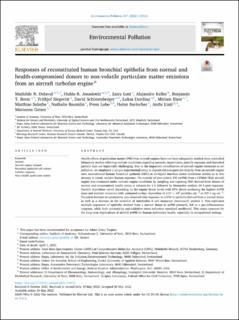Please use this identifier to cite or link to this item:
https://doi.org/10.21256/zhaw-25480| Publication type: | Article in scientific journal |
| Type of review: | Peer review (publication) |
| Title: | Responses of reconstituted human bronchial epithelia from normal and health-compromised donors to non-volatile particulate matter emissions from an aircraft turbofan engine |
| Authors: | Delaval, Mathilde N. Jonsdottir, Hulda R. Leni, Zaira Keller, Alejandro Brem, Benjamin T. Siegerist, Frithjof Schönenberger, David Durdina, Lukas Elser, Miriam Salathe, Matthias Baumlin, Nathalie Lobo, Prem Burtscher, Heinz Liati, Anthi Geiser, Marianne |
| et. al: | No |
| DOI: | 10.1016/j.envpol.2022.119521 10.21256/zhaw-25480 |
| Published in: | Environmental Pollution |
| Volume(Issue): | 307 |
| Issue: | 119521 |
| Issue Date: | 2022 |
| Publisher / Ed. Institution: | Elsevier |
| ISSN: | 0269-7491 1873-6424 |
| Language: | English |
| Subjects: | Aerosol; Aircraft engine exhaust; Bronchial epithelial cell culture; Cellular response; Non-volatile particulate matter; Aircraft; Human; Particulate matter; Vehicle emission; Air pollutant; Air pollution |
| Subject (DDC): | 363: Environmental and security problems 629: Aeronautical, automotive engineering |
| Abstract: | Health effects of particulate matter (PM) from aircraft engines have not been adequately studied since controlled laboratory studies reflecting realistic conditions regarding aerosols, target tissue, particle exposure and deposited particle dose are logistically challenging. Due to the important contributions of aircraft engine emissions to air pollution, we employed a unique experimental setup to deposit exhaust particles directly from an aircraft engine onto reconstituted human bronchial epithelia (HBE) at air-liquid interface under conditions similar to in vivo airways to mimic realistic human exposure. The toxicity of non-volatile PM (nvPM) from a CFM56-7B26 aircraft engine was evaluated under realistic engine conditions by sampling and exposing HBE derived from donors of normal and compromised health status to exhaust for 1 h followed by biomarker analysis 24 h post exposure. Particle deposition varied depending on the engine thrust levels with 85% thrust producing the highest nvPM mass and number emissions with estimated surface deposition of 3.17 × 109 particles cm-2 or 337.1 ng cm-2. Transient increase in cytotoxicity was observed after exposure to nvPM in epithelia derived from a normal donor as well as a decrease in the secretion of interleukin 6 and monocyte chemotactic protein 1. Non-replicated multiple exposures of epithelia derived from a normal donor to nvPM primarily led to a pro-inflammatory response, while both cytotoxicity and oxidative stress induction remained unaffected. This raises concerns for the long-term implications of aircraft nvPM for human pulmonary health, especially in occupational settings. |
| URI: | https://digitalcollection.zhaw.ch/handle/11475/25480 |
| Fulltext version: | Published version |
| License (according to publishing contract): | CC BY-NC 4.0: Attribution - Non commercial 4.0 International |
| Departement: | School of Engineering |
| Organisational Unit: | Centre for Aviation (ZAV) |
| Published as part of the ZHAW project: | AGEAIR II: Vermessung der Gas- und Partikelschadstoffemissionen von Mantelstrom- und Helikoptertriebwerken sowie Abschätzung des Effektes vom Triebwerkverschleiss auf die Emissionsqualität |
| Appears in collections: | Publikationen School of Engineering |
Files in This Item:
| File | Description | Size | Format | |
|---|---|---|---|---|
| 2022_Delaval-etal_Responses-human-bronchial-epithelia-particulate-matter-aircraft.pdf | 4.63 MB | Adobe PDF |  View/Open |
Show full item record
Delaval, M. N., Jonsdottir, H. R., Leni, Z., Keller, A., Brem, B. T., Siegerist, F., Schönenberger, D., Durdina, L., Elser, M., Salathe, M., Baumlin, N., Lobo, P., Burtscher, H., Liati, A., & Geiser, M. (2022). Responses of reconstituted human bronchial epithelia from normal and health-compromised donors to non-volatile particulate matter emissions from an aircraft turbofan engine. Environmental Pollution, 307(119521). https://doi.org/10.1016/j.envpol.2022.119521
Delaval, M.N. et al. (2022) ‘Responses of reconstituted human bronchial epithelia from normal and health-compromised donors to non-volatile particulate matter emissions from an aircraft turbofan engine’, Environmental Pollution, 307(119521). Available at: https://doi.org/10.1016/j.envpol.2022.119521.
M. N. Delaval et al., “Responses of reconstituted human bronchial epithelia from normal and health-compromised donors to non-volatile particulate matter emissions from an aircraft turbofan engine,” Environmental Pollution, vol. 307, no. 119521, 2022, doi: 10.1016/j.envpol.2022.119521.
DELAVAL, Mathilde N., Hulda R. JONSDOTTIR, Zaira LENI, Alejandro KELLER, Benjamin T. BREM, Frithjof SIEGERIST, David SCHÖNENBERGER, Lukas DURDINA, Miriam ELSER, Matthias SALATHE, Nathalie BAUMLIN, Prem LOBO, Heinz BURTSCHER, Anthi LIATI und Marianne GEISER, 2022. Responses of reconstituted human bronchial epithelia from normal and health-compromised donors to non-volatile particulate matter emissions from an aircraft turbofan engine. Environmental Pollution. 2022. Bd. 307, Nr. 119521. DOI 10.1016/j.envpol.2022.119521
Delaval, Mathilde N., Hulda R. Jonsdottir, Zaira Leni, Alejandro Keller, Benjamin T. Brem, Frithjof Siegerist, David Schönenberger, et al. 2022. “Responses of Reconstituted Human Bronchial Epithelia from Normal and Health-Compromised Donors to Non-Volatile Particulate Matter Emissions from an Aircraft Turbofan Engine.” Environmental Pollution 307 (119521). https://doi.org/10.1016/j.envpol.2022.119521.
Delaval, Mathilde N., et al. “Responses of Reconstituted Human Bronchial Epithelia from Normal and Health-Compromised Donors to Non-Volatile Particulate Matter Emissions from an Aircraft Turbofan Engine.” Environmental Pollution, vol. 307, no. 119521, 2022, https://doi.org/10.1016/j.envpol.2022.119521.
Items in DSpace are protected by copyright, with all rights reserved, unless otherwise indicated.